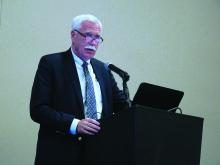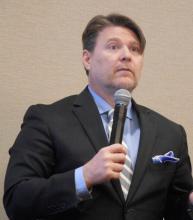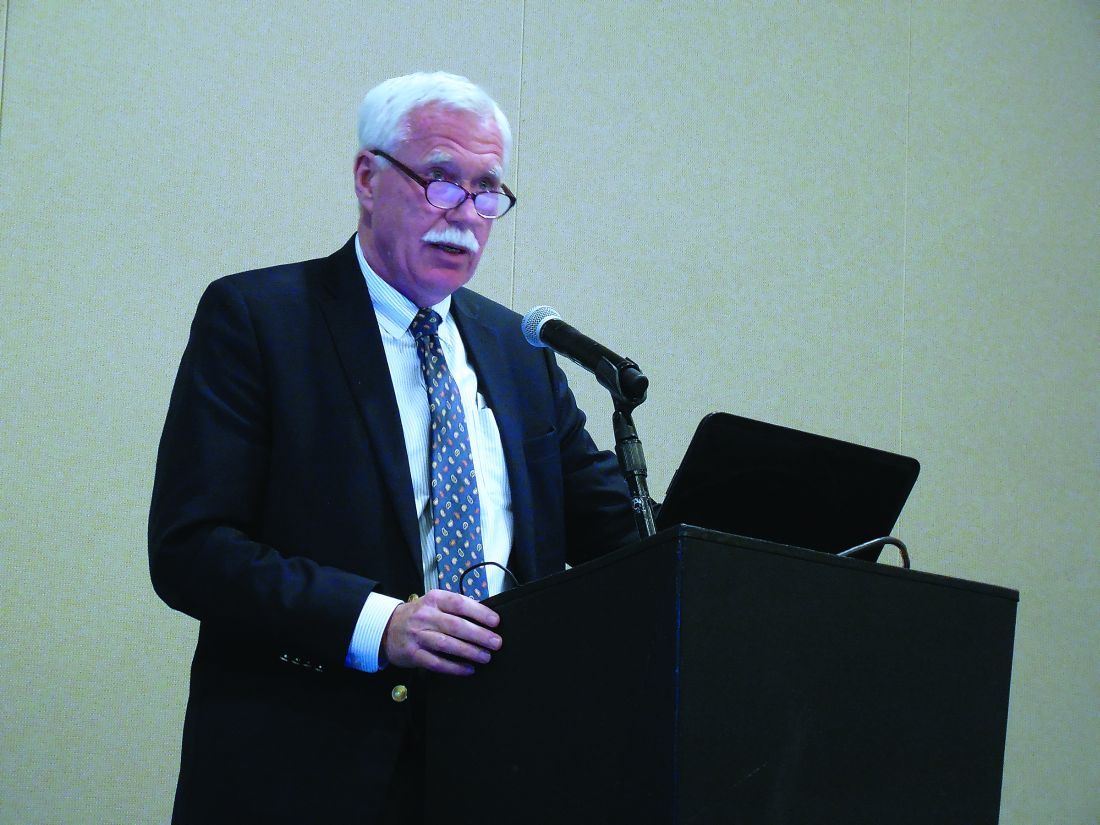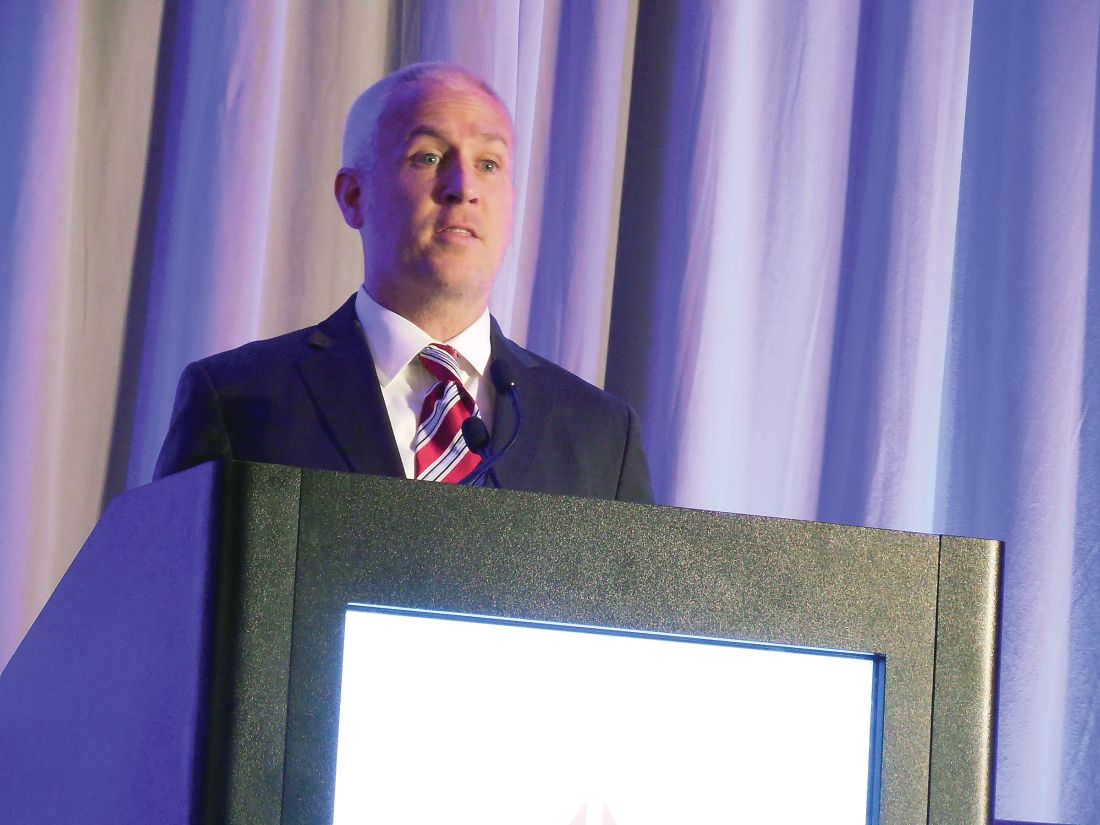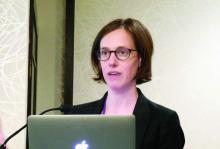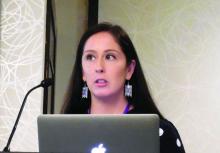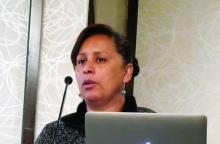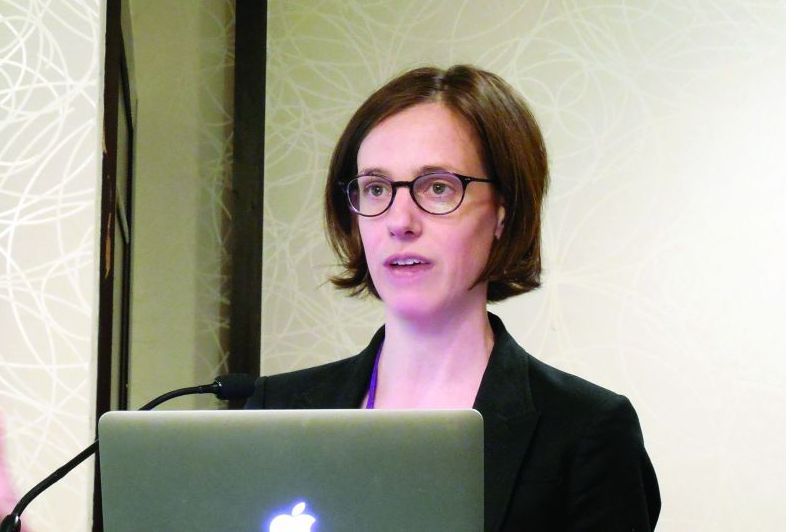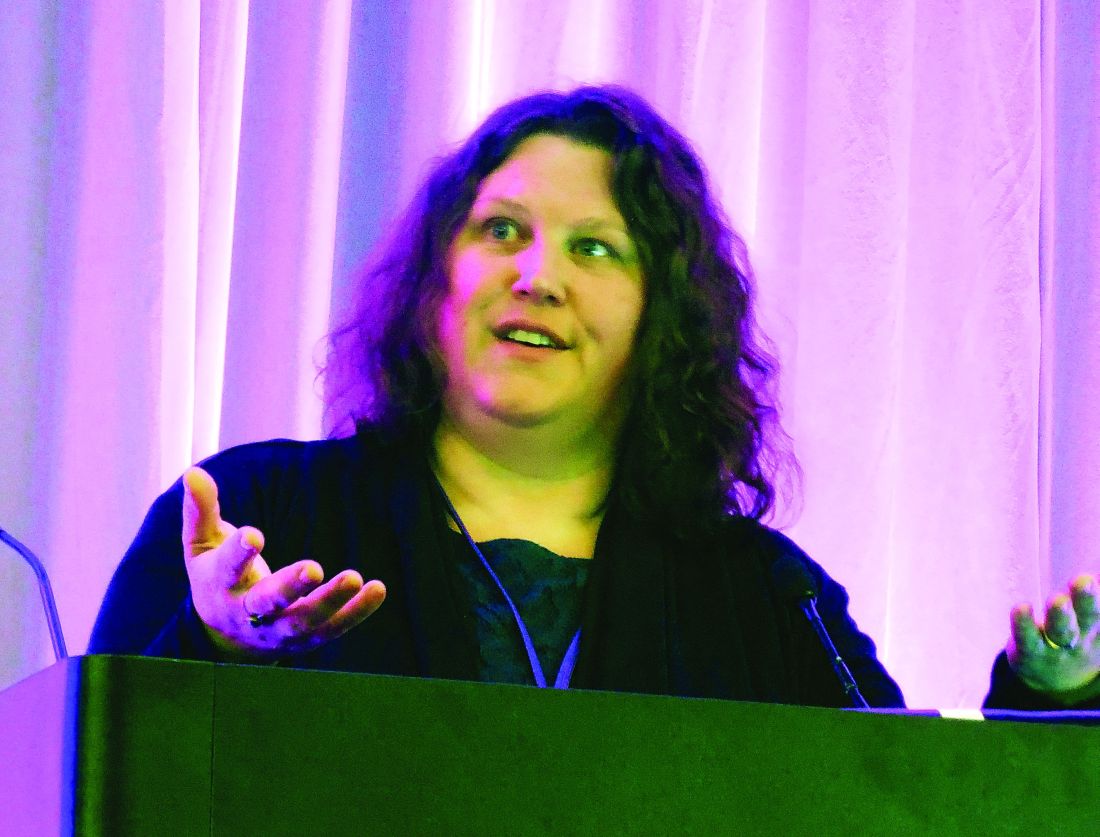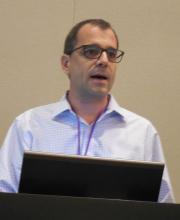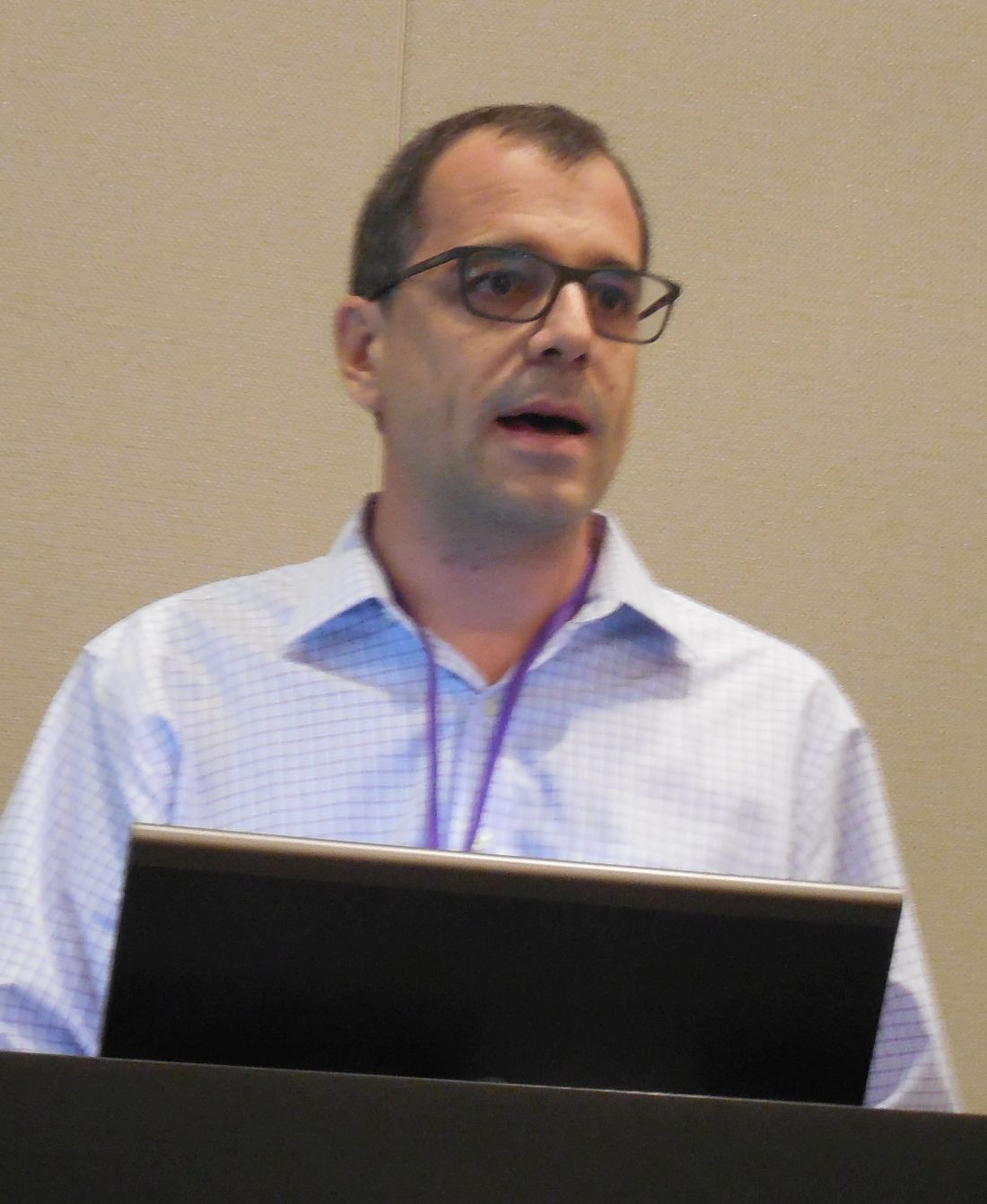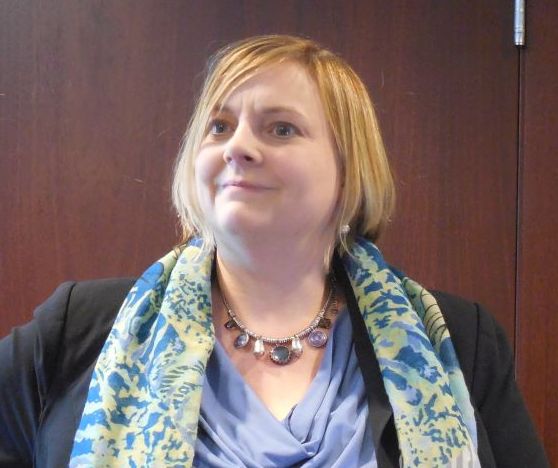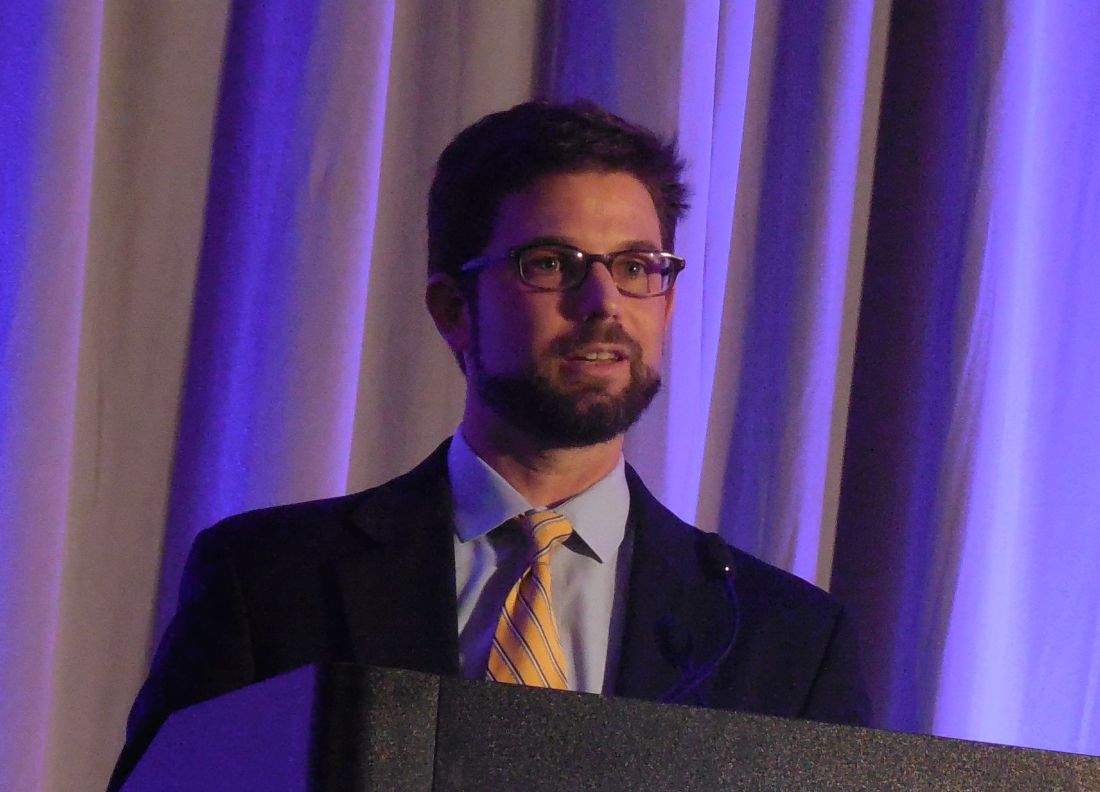User login
Suicide prevention gets ‘standard care’ recommendations
WASHINGTON – The National Action Alliance for Suicide Prevention released in April 2018 what the organization said was the first set of “standard care” recommendations for suicide prevention in people with suicide risk.
Care for people with a suicide risk in the United States “is not working very well. Evidence-based tools exist to detect and manage suicidality, but they are new and infrequently used” by many clinicians, including those seeing suicidal patients in primary care, emergency, or hospital settings, said Michael F. Hogan, PhD, during a session on the new standard-care recommendations at the annual conference of the American Association of Suicidology.
The Action Alliance seeks to have the standard care recommendations widely disseminated and hopes the document will receive endorsement from other organizations, said Dr. Hogan, a health policy consultant in Delmar, N.Y., and a member of the eight-person panel that wrote the recommendations.
These recommendations specify interventions for caregivers in four separate settings: primary care, outpatient behavioral health care (mental health and substance use treatment settings), emergency departments, and behavioral health inpatient care (hospital-level psychiatric or addiction treatment). For each setting, the recommendations highlight one or more core approaches, and then specify standards for identification and assessment, safety planning, means reduction, and follow-up contacts.
For example, within the primary care setting, the recommendations say the goals are to identify suicide risk, enhance the safety for those at risk, refer for specialized care, and provide “caring contacts.” The specifications note that this is achieved with standardized screening and assessment instruments (the recommendations cite eight screening tool options and also suggest three different possible assessment tools); referral as appropriate; a brief safety-planning intervention (the recommendations list five options for this) that includes lethality means reduction along with follow-up to be sure that lethal means have been removed; arranging for rapid follow-up with a mental health professional; and follow-up contact by the primary care clinician within the next 48 hours.
According to Dr. Hogan, a motivation for releasing these recommendations has been the growing U.S. incidence of suicide, rising from 10.4 deaths/100,000 in 2000 to 13.3/100,000 in 2015, a 28% relative increase during a period when the rates of the top killers in the United States – cancer, heart disease, and stroke – were falling. Other telling statistics are that most people who die from suicide had seen a primary care provider during the year before death, and nearly half had seen a primary care provider during the month before their death.
But often the indicators of impending suicide are missed or not acted on. a misperception that contributes to a “failure to ask about suicide risk” on the part of health care professionals, the recommendations said. The document also highlighted the idea that, “most health care professionals are not aware of newly developed brief interventions for suicide, leading to the assumption that they should not ask about suicide because there is nothing practical that can be done in ordinary health care settings.”
One limitation of the recommendations is that they might be interpreted as “standard of care” for medicolegal purposes, warned Alan L. Berman, PhD, during the session’s discussion period. In addition, the evidence base for some of the recommended procedures is not very strong, such as risk stratification, said Dr. Berman, a clinical psychologist and former executive director of the American Association of Suicidology.
Dr. Hogan, Dr. Andrews, and Dr. Berman had no disclosures.
WASHINGTON – The National Action Alliance for Suicide Prevention released in April 2018 what the organization said was the first set of “standard care” recommendations for suicide prevention in people with suicide risk.
Care for people with a suicide risk in the United States “is not working very well. Evidence-based tools exist to detect and manage suicidality, but they are new and infrequently used” by many clinicians, including those seeing suicidal patients in primary care, emergency, or hospital settings, said Michael F. Hogan, PhD, during a session on the new standard-care recommendations at the annual conference of the American Association of Suicidology.
The Action Alliance seeks to have the standard care recommendations widely disseminated and hopes the document will receive endorsement from other organizations, said Dr. Hogan, a health policy consultant in Delmar, N.Y., and a member of the eight-person panel that wrote the recommendations.
These recommendations specify interventions for caregivers in four separate settings: primary care, outpatient behavioral health care (mental health and substance use treatment settings), emergency departments, and behavioral health inpatient care (hospital-level psychiatric or addiction treatment). For each setting, the recommendations highlight one or more core approaches, and then specify standards for identification and assessment, safety planning, means reduction, and follow-up contacts.
For example, within the primary care setting, the recommendations say the goals are to identify suicide risk, enhance the safety for those at risk, refer for specialized care, and provide “caring contacts.” The specifications note that this is achieved with standardized screening and assessment instruments (the recommendations cite eight screening tool options and also suggest three different possible assessment tools); referral as appropriate; a brief safety-planning intervention (the recommendations list five options for this) that includes lethality means reduction along with follow-up to be sure that lethal means have been removed; arranging for rapid follow-up with a mental health professional; and follow-up contact by the primary care clinician within the next 48 hours.
According to Dr. Hogan, a motivation for releasing these recommendations has been the growing U.S. incidence of suicide, rising from 10.4 deaths/100,000 in 2000 to 13.3/100,000 in 2015, a 28% relative increase during a period when the rates of the top killers in the United States – cancer, heart disease, and stroke – were falling. Other telling statistics are that most people who die from suicide had seen a primary care provider during the year before death, and nearly half had seen a primary care provider during the month before their death.
But often the indicators of impending suicide are missed or not acted on. a misperception that contributes to a “failure to ask about suicide risk” on the part of health care professionals, the recommendations said. The document also highlighted the idea that, “most health care professionals are not aware of newly developed brief interventions for suicide, leading to the assumption that they should not ask about suicide because there is nothing practical that can be done in ordinary health care settings.”
One limitation of the recommendations is that they might be interpreted as “standard of care” for medicolegal purposes, warned Alan L. Berman, PhD, during the session’s discussion period. In addition, the evidence base for some of the recommended procedures is not very strong, such as risk stratification, said Dr. Berman, a clinical psychologist and former executive director of the American Association of Suicidology.
Dr. Hogan, Dr. Andrews, and Dr. Berman had no disclosures.
WASHINGTON – The National Action Alliance for Suicide Prevention released in April 2018 what the organization said was the first set of “standard care” recommendations for suicide prevention in people with suicide risk.
Care for people with a suicide risk in the United States “is not working very well. Evidence-based tools exist to detect and manage suicidality, but they are new and infrequently used” by many clinicians, including those seeing suicidal patients in primary care, emergency, or hospital settings, said Michael F. Hogan, PhD, during a session on the new standard-care recommendations at the annual conference of the American Association of Suicidology.
The Action Alliance seeks to have the standard care recommendations widely disseminated and hopes the document will receive endorsement from other organizations, said Dr. Hogan, a health policy consultant in Delmar, N.Y., and a member of the eight-person panel that wrote the recommendations.
These recommendations specify interventions for caregivers in four separate settings: primary care, outpatient behavioral health care (mental health and substance use treatment settings), emergency departments, and behavioral health inpatient care (hospital-level psychiatric or addiction treatment). For each setting, the recommendations highlight one or more core approaches, and then specify standards for identification and assessment, safety planning, means reduction, and follow-up contacts.
For example, within the primary care setting, the recommendations say the goals are to identify suicide risk, enhance the safety for those at risk, refer for specialized care, and provide “caring contacts.” The specifications note that this is achieved with standardized screening and assessment instruments (the recommendations cite eight screening tool options and also suggest three different possible assessment tools); referral as appropriate; a brief safety-planning intervention (the recommendations list five options for this) that includes lethality means reduction along with follow-up to be sure that lethal means have been removed; arranging for rapid follow-up with a mental health professional; and follow-up contact by the primary care clinician within the next 48 hours.
According to Dr. Hogan, a motivation for releasing these recommendations has been the growing U.S. incidence of suicide, rising from 10.4 deaths/100,000 in 2000 to 13.3/100,000 in 2015, a 28% relative increase during a period when the rates of the top killers in the United States – cancer, heart disease, and stroke – were falling. Other telling statistics are that most people who die from suicide had seen a primary care provider during the year before death, and nearly half had seen a primary care provider during the month before their death.
But often the indicators of impending suicide are missed or not acted on. a misperception that contributes to a “failure to ask about suicide risk” on the part of health care professionals, the recommendations said. The document also highlighted the idea that, “most health care professionals are not aware of newly developed brief interventions for suicide, leading to the assumption that they should not ask about suicide because there is nothing practical that can be done in ordinary health care settings.”
One limitation of the recommendations is that they might be interpreted as “standard of care” for medicolegal purposes, warned Alan L. Berman, PhD, during the session’s discussion period. In addition, the evidence base for some of the recommended procedures is not very strong, such as risk stratification, said Dr. Berman, a clinical psychologist and former executive director of the American Association of Suicidology.
Dr. Hogan, Dr. Andrews, and Dr. Berman had no disclosures.
REPORTING FROM THE AAS ANNUAL CONFERENCE
U.S. public largely ignores firearm access and suicide completion link
WASHINGTON – The evidence linking firearm access and suicide completion is largely ignored in current U.S. discussions on guns, Michael D. Anestis, PhD, said at the annual conference of the American Association of Suicidology.
“Only a tiny fraction of media discussions on gun deaths involve suicide. We must make a concerted and sustained effort to change this conversation,” said Dr. Anestis, a clinical psychologist at the University of Southern Mississippi in Hattiesburg. When the relationship between firearms and suicide is discussed, it often is as a “footnote” and includes a lot of inaccurate information.
Dr. Anestis reviewed results from a survey he and his associates ran in 2017 that documented these inaccurate beliefs regarding firearms and suicide. The researchers had 300 American adults who owned at least one firearm complete a questionnaire on their practices for firearm storage and their beliefs on the connections between firearm storage and suicide risk. The results showed a clear link between unsafe firearm storage and reduced belief of a link between firearm access and suicide risk (J Affect Disord. 2018 Feb;227:530-5). They also showed that fearlessness about death moderated the relationship: People with a higher level of fearlessness showed a tighter link between storage practices and beliefs about suicide risk.
During the conference, Dr. Anestis and his associates reported additional, as-yet unpublished findings that further detailed risks for suicide among gun owners. A survey of 100 adults from the Hattiesburg area showed that greater experience firing a gun linked with “factors thought to facilitate the transition from suicidal desire to suicidal behavior. We need to consider an individual’s experience and comfort with firearms, not just ownership and storage,” Dr. Anestis said.
. But additional research from his group showed that another route to acquiring “capability” for suicide, such as fearlessness of death, can occur through exposure to violent video games.
Dr. Anestis had no disclosures.
;
WASHINGTON – The evidence linking firearm access and suicide completion is largely ignored in current U.S. discussions on guns, Michael D. Anestis, PhD, said at the annual conference of the American Association of Suicidology.
“Only a tiny fraction of media discussions on gun deaths involve suicide. We must make a concerted and sustained effort to change this conversation,” said Dr. Anestis, a clinical psychologist at the University of Southern Mississippi in Hattiesburg. When the relationship between firearms and suicide is discussed, it often is as a “footnote” and includes a lot of inaccurate information.
Dr. Anestis reviewed results from a survey he and his associates ran in 2017 that documented these inaccurate beliefs regarding firearms and suicide. The researchers had 300 American adults who owned at least one firearm complete a questionnaire on their practices for firearm storage and their beliefs on the connections between firearm storage and suicide risk. The results showed a clear link between unsafe firearm storage and reduced belief of a link between firearm access and suicide risk (J Affect Disord. 2018 Feb;227:530-5). They also showed that fearlessness about death moderated the relationship: People with a higher level of fearlessness showed a tighter link between storage practices and beliefs about suicide risk.
During the conference, Dr. Anestis and his associates reported additional, as-yet unpublished findings that further detailed risks for suicide among gun owners. A survey of 100 adults from the Hattiesburg area showed that greater experience firing a gun linked with “factors thought to facilitate the transition from suicidal desire to suicidal behavior. We need to consider an individual’s experience and comfort with firearms, not just ownership and storage,” Dr. Anestis said.
. But additional research from his group showed that another route to acquiring “capability” for suicide, such as fearlessness of death, can occur through exposure to violent video games.
Dr. Anestis had no disclosures.
;
WASHINGTON – The evidence linking firearm access and suicide completion is largely ignored in current U.S. discussions on guns, Michael D. Anestis, PhD, said at the annual conference of the American Association of Suicidology.
“Only a tiny fraction of media discussions on gun deaths involve suicide. We must make a concerted and sustained effort to change this conversation,” said Dr. Anestis, a clinical psychologist at the University of Southern Mississippi in Hattiesburg. When the relationship between firearms and suicide is discussed, it often is as a “footnote” and includes a lot of inaccurate information.
Dr. Anestis reviewed results from a survey he and his associates ran in 2017 that documented these inaccurate beliefs regarding firearms and suicide. The researchers had 300 American adults who owned at least one firearm complete a questionnaire on their practices for firearm storage and their beliefs on the connections between firearm storage and suicide risk. The results showed a clear link between unsafe firearm storage and reduced belief of a link between firearm access and suicide risk (J Affect Disord. 2018 Feb;227:530-5). They also showed that fearlessness about death moderated the relationship: People with a higher level of fearlessness showed a tighter link between storage practices and beliefs about suicide risk.
During the conference, Dr. Anestis and his associates reported additional, as-yet unpublished findings that further detailed risks for suicide among gun owners. A survey of 100 adults from the Hattiesburg area showed that greater experience firing a gun linked with “factors thought to facilitate the transition from suicidal desire to suicidal behavior. We need to consider an individual’s experience and comfort with firearms, not just ownership and storage,” Dr. Anestis said.
. But additional research from his group showed that another route to acquiring “capability” for suicide, such as fearlessness of death, can occur through exposure to violent video games.
Dr. Anestis had no disclosures.
;
REPORTING FROM THE AAS ANNUAL CONFERENCE
Formula gets high marks for predicting suicide risk among Apache youth
WASHINGTON – Using machine learning and data from 2,466 Apache tribal members, researchers developed a formula for predicting suicide attempts among youths aged 15-24 years with a “pretty high” level of accuracy, Emily E. Haroz, PhD, said at the annual conference of the American Association of Suicidology.
The area under the receiver operating characteristic curve for the best performing predictive model was 0.806, said Dr. Haroz, a psychiatric epidemiologist at Johns Hopkins University in Baltimore. This compared with an area under the curve of 0.57 for prediction based solely on prior attempts, which is a “very low” predictive score, Dr. Haroz noted. The area under the curve is a performance measure used widely to make predictions.
Previously, colleagues of Dr. Haroz from the Johns Hopkins Center for American Indian Health reported that implementation of the Celebrating Life surveillance system in 2007 strongly linked with a dramatic reduction in suicide deaths on the Apache reservation during 2007-2012, compared with 2001-2006. Overall, Apache suicide deaths fell from 40/100,000 during the earlier period to 25/100,000 after the Celebrating Life program began, a 38% relative reduction (Am J Public Health. 2016. Dec; 106[12]:183-9). Among youths aged 15-24 years old, the suicide death rate dropped from 129/100,000 to 99/100,000, a 23% relative decrease.
“We don’t really know much about how to predict suicide risk,” Dr. Haroz noted, and most of what’s known has been based on retrospective data from hospital-based surveillance. Improved prediction models can help case managers more quickly identify and focus on people who are at highest risk, she added.
Other researchers from the Johns Hopkins Center for American Indian Health described a new intervention program they have developed in collaboration with the Apache tribal leaders that uses tribal elders to teach tribal culture, values, and beliefs to students 11-15 years old. Begun in 2015, “we see this as upstream suicide prevention,” said Victoria O’Keefe, PhD, a clinical psychologist with the Johns Hopkins program. “What is unique about the program is that the elders go into the classrooms,” for 45- to 60-minute sessions done monthly.
Questionnaires completed by participating students at the start of the program highlighted how ubiquitous suicide remains in the Apache community. A quarter of the students said they had a family member who had attempted suicide, more than a third knew a friend who had attempted suicide, and 15% reported losing a friend, sibling, or parent to suicide. In addition, roughly half of the students said that they knew an adult who was important in their life with a substance abuse problem, that they had no strong sense of belonging to an ethnic culture, and that they had not spent time learning about their culture, Dr. O’Keefe said.
Initial data from questionnaires completed at the end of the elders program showed high levels of enjoyment among the students and high levels of retention of some information. For example, after the elders’ program, 96% could identify their clan, and 96% could say what is sacred about the Apache land, she noted. Further data analysis is in progress, Dr. O’Keefe said, and she and her associates are adapting the elders program for use by other Native communities.
Dr. Haroz, Dr. O’Keefe, Ms. Goklish, and Dr. Cwik had no disclosures.
WASHINGTON – Using machine learning and data from 2,466 Apache tribal members, researchers developed a formula for predicting suicide attempts among youths aged 15-24 years with a “pretty high” level of accuracy, Emily E. Haroz, PhD, said at the annual conference of the American Association of Suicidology.
The area under the receiver operating characteristic curve for the best performing predictive model was 0.806, said Dr. Haroz, a psychiatric epidemiologist at Johns Hopkins University in Baltimore. This compared with an area under the curve of 0.57 for prediction based solely on prior attempts, which is a “very low” predictive score, Dr. Haroz noted. The area under the curve is a performance measure used widely to make predictions.
Previously, colleagues of Dr. Haroz from the Johns Hopkins Center for American Indian Health reported that implementation of the Celebrating Life surveillance system in 2007 strongly linked with a dramatic reduction in suicide deaths on the Apache reservation during 2007-2012, compared with 2001-2006. Overall, Apache suicide deaths fell from 40/100,000 during the earlier period to 25/100,000 after the Celebrating Life program began, a 38% relative reduction (Am J Public Health. 2016. Dec; 106[12]:183-9). Among youths aged 15-24 years old, the suicide death rate dropped from 129/100,000 to 99/100,000, a 23% relative decrease.
“We don’t really know much about how to predict suicide risk,” Dr. Haroz noted, and most of what’s known has been based on retrospective data from hospital-based surveillance. Improved prediction models can help case managers more quickly identify and focus on people who are at highest risk, she added.
Other researchers from the Johns Hopkins Center for American Indian Health described a new intervention program they have developed in collaboration with the Apache tribal leaders that uses tribal elders to teach tribal culture, values, and beliefs to students 11-15 years old. Begun in 2015, “we see this as upstream suicide prevention,” said Victoria O’Keefe, PhD, a clinical psychologist with the Johns Hopkins program. “What is unique about the program is that the elders go into the classrooms,” for 45- to 60-minute sessions done monthly.
Questionnaires completed by participating students at the start of the program highlighted how ubiquitous suicide remains in the Apache community. A quarter of the students said they had a family member who had attempted suicide, more than a third knew a friend who had attempted suicide, and 15% reported losing a friend, sibling, or parent to suicide. In addition, roughly half of the students said that they knew an adult who was important in their life with a substance abuse problem, that they had no strong sense of belonging to an ethnic culture, and that they had not spent time learning about their culture, Dr. O’Keefe said.
Initial data from questionnaires completed at the end of the elders program showed high levels of enjoyment among the students and high levels of retention of some information. For example, after the elders’ program, 96% could identify their clan, and 96% could say what is sacred about the Apache land, she noted. Further data analysis is in progress, Dr. O’Keefe said, and she and her associates are adapting the elders program for use by other Native communities.
Dr. Haroz, Dr. O’Keefe, Ms. Goklish, and Dr. Cwik had no disclosures.
WASHINGTON – Using machine learning and data from 2,466 Apache tribal members, researchers developed a formula for predicting suicide attempts among youths aged 15-24 years with a “pretty high” level of accuracy, Emily E. Haroz, PhD, said at the annual conference of the American Association of Suicidology.
The area under the receiver operating characteristic curve for the best performing predictive model was 0.806, said Dr. Haroz, a psychiatric epidemiologist at Johns Hopkins University in Baltimore. This compared with an area under the curve of 0.57 for prediction based solely on prior attempts, which is a “very low” predictive score, Dr. Haroz noted. The area under the curve is a performance measure used widely to make predictions.
Previously, colleagues of Dr. Haroz from the Johns Hopkins Center for American Indian Health reported that implementation of the Celebrating Life surveillance system in 2007 strongly linked with a dramatic reduction in suicide deaths on the Apache reservation during 2007-2012, compared with 2001-2006. Overall, Apache suicide deaths fell from 40/100,000 during the earlier period to 25/100,000 after the Celebrating Life program began, a 38% relative reduction (Am J Public Health. 2016. Dec; 106[12]:183-9). Among youths aged 15-24 years old, the suicide death rate dropped from 129/100,000 to 99/100,000, a 23% relative decrease.
“We don’t really know much about how to predict suicide risk,” Dr. Haroz noted, and most of what’s known has been based on retrospective data from hospital-based surveillance. Improved prediction models can help case managers more quickly identify and focus on people who are at highest risk, she added.
Other researchers from the Johns Hopkins Center for American Indian Health described a new intervention program they have developed in collaboration with the Apache tribal leaders that uses tribal elders to teach tribal culture, values, and beliefs to students 11-15 years old. Begun in 2015, “we see this as upstream suicide prevention,” said Victoria O’Keefe, PhD, a clinical psychologist with the Johns Hopkins program. “What is unique about the program is that the elders go into the classrooms,” for 45- to 60-minute sessions done monthly.
Questionnaires completed by participating students at the start of the program highlighted how ubiquitous suicide remains in the Apache community. A quarter of the students said they had a family member who had attempted suicide, more than a third knew a friend who had attempted suicide, and 15% reported losing a friend, sibling, or parent to suicide. In addition, roughly half of the students said that they knew an adult who was important in their life with a substance abuse problem, that they had no strong sense of belonging to an ethnic culture, and that they had not spent time learning about their culture, Dr. O’Keefe said.
Initial data from questionnaires completed at the end of the elders program showed high levels of enjoyment among the students and high levels of retention of some information. For example, after the elders’ program, 96% could identify their clan, and 96% could say what is sacred about the Apache land, she noted. Further data analysis is in progress, Dr. O’Keefe said, and she and her associates are adapting the elders program for use by other Native communities.
Dr. Haroz, Dr. O’Keefe, Ms. Goklish, and Dr. Cwik had no disclosures.
Key clinical point: The machine-learning process used data collected through the prospective surveillance program on suicide ideation, nonsuicidal self-injury, suicide attempts, binge substance use, and suicide deaths.
Major finding: The new formula produced an area under the receiver operating characteristic curve of 0.806 for predicting youth suicide attempts.
Study details: Development of the prediction formula used data from 2,466 members of the Apache tribe.
Disclosures: Dr. Haroz, Dr. O’Keefe, Ms. Goklish, and Dr. Cwik had no disclosures.
Suicide prevention starts with the patient’s narrative
WASHINGTON – An effective approach to suicide prevention engages the patient in a therapeutic relationship that starts with the patient’s narrative, Katherine A. Comtois, PhD, said at the American Association of Suicidality annual conference.
“The narrative should be the first touch” with the patient, advised Dr. Comtois, professor of psychiatry at the University of Washington, Seattle. “Start the narrative and form a connection, and then get to the other stuff.” She also recommended that therapists place themselves next to the patient, “court” the patient, be persistent, give positive reinforcement, and “give it all you’ve got.”
She endorsed the Aeschi model for suicide prevention, the treatment approaches recommended in The Way Forward, published in 2014 by the National Action Alliance for Suicide Prevention, and application of dialectical behavior therapy.
Dr. Comtois subdivided therapeutic interventions into two broad categories: management and treatment.
Management uses interventions aimed at modifying risk factors and reducing risks that relate to suicide, such as connectedness, treatment of the diagnosis, means safety, and safety planning; external factors that affect suicide risk. Although a collaborative approach between the therapist and patient is ideal for achieving management goals, it is not mandatory.
Treatment involves interventions that get at the internal factors that intrinsically drive a patient to suicide and aims to resolve the risk they pose. By necessity, treatment is a collaborative process. Ideally over time, the collaboration allows the patients gain confidence and take responsibility for self-managing their internal suicide risks.
She stressed the importance of a therapist orienting a patient to the management style to expect, “so what you do is not a surprise.” The therapist should listen to the patient’s goals, and carefully review expectations and a step-by-step plan. If the patient identifies potential problems and limitations, Dr. Comtois suggested commiserating with the patient about difficulties but not justifying them. For example, reviewing with patients how likely you will be to answer their phone call, what would likely happen during and as a result of a call, and offer the patients your advice on what to do if you can’t answer their call.
Dr. Comtois acknowledged that some clinicians fear managing and treating a suicidal patient, and advised “getting past your fear to help the client find a path forward. If you can get past your fear” the intervention often boils down to “clinical common sense: Things you would know how to handle if suicide weren’t involved.” If clinicians feel they can’t help, she suggested learning new skills to make assistance possible, or referring the patient to someone else who could help. “Negligence is not making a wrong decision; it’s doing nothing. Liability risk is often a huge fear,” but if the clinician at least makes a consult, that reduces the risk of potential negligence. She warned against referring suicidal patients to a hospital emergency department. “In this day and age, the emergency department is not a source of treatment; it’s a gatekeeper.”
While published evidence documents the efficacy of dialectical behavior therapy and case management for preventing suicide and self-harm biological treatments, including antidepressants, lithium, and other psychopharmacology have not been effective, she said.
Dr. Comtois had no disclosures.
WASHINGTON – An effective approach to suicide prevention engages the patient in a therapeutic relationship that starts with the patient’s narrative, Katherine A. Comtois, PhD, said at the American Association of Suicidality annual conference.
“The narrative should be the first touch” with the patient, advised Dr. Comtois, professor of psychiatry at the University of Washington, Seattle. “Start the narrative and form a connection, and then get to the other stuff.” She also recommended that therapists place themselves next to the patient, “court” the patient, be persistent, give positive reinforcement, and “give it all you’ve got.”
She endorsed the Aeschi model for suicide prevention, the treatment approaches recommended in The Way Forward, published in 2014 by the National Action Alliance for Suicide Prevention, and application of dialectical behavior therapy.
Dr. Comtois subdivided therapeutic interventions into two broad categories: management and treatment.
Management uses interventions aimed at modifying risk factors and reducing risks that relate to suicide, such as connectedness, treatment of the diagnosis, means safety, and safety planning; external factors that affect suicide risk. Although a collaborative approach between the therapist and patient is ideal for achieving management goals, it is not mandatory.
Treatment involves interventions that get at the internal factors that intrinsically drive a patient to suicide and aims to resolve the risk they pose. By necessity, treatment is a collaborative process. Ideally over time, the collaboration allows the patients gain confidence and take responsibility for self-managing their internal suicide risks.
She stressed the importance of a therapist orienting a patient to the management style to expect, “so what you do is not a surprise.” The therapist should listen to the patient’s goals, and carefully review expectations and a step-by-step plan. If the patient identifies potential problems and limitations, Dr. Comtois suggested commiserating with the patient about difficulties but not justifying them. For example, reviewing with patients how likely you will be to answer their phone call, what would likely happen during and as a result of a call, and offer the patients your advice on what to do if you can’t answer their call.
Dr. Comtois acknowledged that some clinicians fear managing and treating a suicidal patient, and advised “getting past your fear to help the client find a path forward. If you can get past your fear” the intervention often boils down to “clinical common sense: Things you would know how to handle if suicide weren’t involved.” If clinicians feel they can’t help, she suggested learning new skills to make assistance possible, or referring the patient to someone else who could help. “Negligence is not making a wrong decision; it’s doing nothing. Liability risk is often a huge fear,” but if the clinician at least makes a consult, that reduces the risk of potential negligence. She warned against referring suicidal patients to a hospital emergency department. “In this day and age, the emergency department is not a source of treatment; it’s a gatekeeper.”
While published evidence documents the efficacy of dialectical behavior therapy and case management for preventing suicide and self-harm biological treatments, including antidepressants, lithium, and other psychopharmacology have not been effective, she said.
Dr. Comtois had no disclosures.
WASHINGTON – An effective approach to suicide prevention engages the patient in a therapeutic relationship that starts with the patient’s narrative, Katherine A. Comtois, PhD, said at the American Association of Suicidality annual conference.
“The narrative should be the first touch” with the patient, advised Dr. Comtois, professor of psychiatry at the University of Washington, Seattle. “Start the narrative and form a connection, and then get to the other stuff.” She also recommended that therapists place themselves next to the patient, “court” the patient, be persistent, give positive reinforcement, and “give it all you’ve got.”
She endorsed the Aeschi model for suicide prevention, the treatment approaches recommended in The Way Forward, published in 2014 by the National Action Alliance for Suicide Prevention, and application of dialectical behavior therapy.
Dr. Comtois subdivided therapeutic interventions into two broad categories: management and treatment.
Management uses interventions aimed at modifying risk factors and reducing risks that relate to suicide, such as connectedness, treatment of the diagnosis, means safety, and safety planning; external factors that affect suicide risk. Although a collaborative approach between the therapist and patient is ideal for achieving management goals, it is not mandatory.
Treatment involves interventions that get at the internal factors that intrinsically drive a patient to suicide and aims to resolve the risk they pose. By necessity, treatment is a collaborative process. Ideally over time, the collaboration allows the patients gain confidence and take responsibility for self-managing their internal suicide risks.
She stressed the importance of a therapist orienting a patient to the management style to expect, “so what you do is not a surprise.” The therapist should listen to the patient’s goals, and carefully review expectations and a step-by-step plan. If the patient identifies potential problems and limitations, Dr. Comtois suggested commiserating with the patient about difficulties but not justifying them. For example, reviewing with patients how likely you will be to answer their phone call, what would likely happen during and as a result of a call, and offer the patients your advice on what to do if you can’t answer their call.
Dr. Comtois acknowledged that some clinicians fear managing and treating a suicidal patient, and advised “getting past your fear to help the client find a path forward. If you can get past your fear” the intervention often boils down to “clinical common sense: Things you would know how to handle if suicide weren’t involved.” If clinicians feel they can’t help, she suggested learning new skills to make assistance possible, or referring the patient to someone else who could help. “Negligence is not making a wrong decision; it’s doing nothing. Liability risk is often a huge fear,” but if the clinician at least makes a consult, that reduces the risk of potential negligence. She warned against referring suicidal patients to a hospital emergency department. “In this day and age, the emergency department is not a source of treatment; it’s a gatekeeper.”
While published evidence documents the efficacy of dialectical behavior therapy and case management for preventing suicide and self-harm biological treatments, including antidepressants, lithium, and other psychopharmacology have not been effective, she said.
Dr. Comtois had no disclosures.
U.S. youth suicide prevention saved nearly 900 lives
WASHINGTON – A U.S. grant program that was started in 2004 to fund youth suicide prevention efforts throughout the country was linked with nearly 900 youth suicide deaths prevented by 2015, according to a matched, case-control analysis.
U.S. counties with a youth suicide prevention effort funded by a grant from the federal Garrett Lee Smith (GLS) Memorial Suicide Prevention program had an average 1.09 fewer youth suicide deaths per 100,000 youths (10-24 years old) 2 years after ongoing funding began, when compared with matched U.S. counties without a GLS-funded program, said Mr. Garraza, an analyst with ICF International in New York. Counties that had GLS-funded programs operating for 3 years showed an average reduction in youth suicide death of roughly 2 fewer deaths per 100,000 population, compared with control counties, and counties with programs in operation for 4 years showed a reduction of roughly 3 fewer deaths per 100,000 population.
“These extremely important data show convincingly that if we want to save lives, suicide prevention can’t be a one-and-done. said Richard McKeon, PhD, chief of the Suicide Prevention Branch of the Substance Abuse and Mental Health Services Administration, the U.S. agency that administers the GLS grant program and commissioned ICF International to analyze the grant program’s effects.
As of October 2017, the GLS grant initiative had made nearly 200 awards to youth suicide prevention programs that operated in all 50 states, the District of Columbia, one territory, and among 49 Native American tribes, Mr. Garraza said.
To assess the effects of the GLS grants on suicide death rates in people aged 10-24 years, Mr. Garraza and his associates used U.S. suicide data collected in 2,095 counties throughout the country that each had more than 3,000 resident youths, including 1,126 counties that had, as of 2015, been exposed to at least 1 year of a program sponsored by a GLS grant that began before 2010 and 969 counties without any GLS-grant exposure. After the counties in each subgroup were propensity-score matched using several criteria, including numbers of youth by specific age, race, household income, employment rates, health insurance status, and urbanization, the researchers analyzed suicide death rates in 481 counties with 1-4 years of exposure of a GLS-funded prevention program and in 851 counties with no exposure.
Their analysis estimated that 882 fewer suicide deaths occurred among youths in counties with GLS-funded programs, compared with the expected suicide mortality based on the unexposed counties.
In addition to showing statistically significant mortality reductions among youths in the counties with GLS-funded programs, compared with the counties with no such programs, the analysis showed, as expected, no difference between the intervention and control counties in rates of suicide deaths among adults and no difference in youth-mortality from causes other than suicide, which indicated that the observed differences linked with GLS funding were specific for youth suicides.
The current analysis looking at the effects of GLS funding on youth suicide deaths rates follows a prior report from the same researchers with similar findings using data collected through 2010 (Am J Public Health. 2015 May;105[5]:986-93). They also published two prior reports that used a similar analysis to assess the effects of GLS-funded suicide prevention programs on suicide attempt rates. One of those reports showed that GLS-funded programs linked with a cut in suicide attempts of nearly 5 per 1,000 population (JAMA Psychiatry. 2015 Nov;72[11]:1143-9), and the second showed that this effect on suicide attempts was cost effective when the cost of the grants was compared with the money saved from avoided emergency department visits and hospitalizations (Suicide Life Threat Behav. 2018 Feb;48[1]:3-11).
WASHINGTON – A U.S. grant program that was started in 2004 to fund youth suicide prevention efforts throughout the country was linked with nearly 900 youth suicide deaths prevented by 2015, according to a matched, case-control analysis.
U.S. counties with a youth suicide prevention effort funded by a grant from the federal Garrett Lee Smith (GLS) Memorial Suicide Prevention program had an average 1.09 fewer youth suicide deaths per 100,000 youths (10-24 years old) 2 years after ongoing funding began, when compared with matched U.S. counties without a GLS-funded program, said Mr. Garraza, an analyst with ICF International in New York. Counties that had GLS-funded programs operating for 3 years showed an average reduction in youth suicide death of roughly 2 fewer deaths per 100,000 population, compared with control counties, and counties with programs in operation for 4 years showed a reduction of roughly 3 fewer deaths per 100,000 population.
“These extremely important data show convincingly that if we want to save lives, suicide prevention can’t be a one-and-done. said Richard McKeon, PhD, chief of the Suicide Prevention Branch of the Substance Abuse and Mental Health Services Administration, the U.S. agency that administers the GLS grant program and commissioned ICF International to analyze the grant program’s effects.
As of October 2017, the GLS grant initiative had made nearly 200 awards to youth suicide prevention programs that operated in all 50 states, the District of Columbia, one territory, and among 49 Native American tribes, Mr. Garraza said.
To assess the effects of the GLS grants on suicide death rates in people aged 10-24 years, Mr. Garraza and his associates used U.S. suicide data collected in 2,095 counties throughout the country that each had more than 3,000 resident youths, including 1,126 counties that had, as of 2015, been exposed to at least 1 year of a program sponsored by a GLS grant that began before 2010 and 969 counties without any GLS-grant exposure. After the counties in each subgroup were propensity-score matched using several criteria, including numbers of youth by specific age, race, household income, employment rates, health insurance status, and urbanization, the researchers analyzed suicide death rates in 481 counties with 1-4 years of exposure of a GLS-funded prevention program and in 851 counties with no exposure.
Their analysis estimated that 882 fewer suicide deaths occurred among youths in counties with GLS-funded programs, compared with the expected suicide mortality based on the unexposed counties.
In addition to showing statistically significant mortality reductions among youths in the counties with GLS-funded programs, compared with the counties with no such programs, the analysis showed, as expected, no difference between the intervention and control counties in rates of suicide deaths among adults and no difference in youth-mortality from causes other than suicide, which indicated that the observed differences linked with GLS funding were specific for youth suicides.
The current analysis looking at the effects of GLS funding on youth suicide deaths rates follows a prior report from the same researchers with similar findings using data collected through 2010 (Am J Public Health. 2015 May;105[5]:986-93). They also published two prior reports that used a similar analysis to assess the effects of GLS-funded suicide prevention programs on suicide attempt rates. One of those reports showed that GLS-funded programs linked with a cut in suicide attempts of nearly 5 per 1,000 population (JAMA Psychiatry. 2015 Nov;72[11]:1143-9), and the second showed that this effect on suicide attempts was cost effective when the cost of the grants was compared with the money saved from avoided emergency department visits and hospitalizations (Suicide Life Threat Behav. 2018 Feb;48[1]:3-11).
WASHINGTON – A U.S. grant program that was started in 2004 to fund youth suicide prevention efforts throughout the country was linked with nearly 900 youth suicide deaths prevented by 2015, according to a matched, case-control analysis.
U.S. counties with a youth suicide prevention effort funded by a grant from the federal Garrett Lee Smith (GLS) Memorial Suicide Prevention program had an average 1.09 fewer youth suicide deaths per 100,000 youths (10-24 years old) 2 years after ongoing funding began, when compared with matched U.S. counties without a GLS-funded program, said Mr. Garraza, an analyst with ICF International in New York. Counties that had GLS-funded programs operating for 3 years showed an average reduction in youth suicide death of roughly 2 fewer deaths per 100,000 population, compared with control counties, and counties with programs in operation for 4 years showed a reduction of roughly 3 fewer deaths per 100,000 population.
“These extremely important data show convincingly that if we want to save lives, suicide prevention can’t be a one-and-done. said Richard McKeon, PhD, chief of the Suicide Prevention Branch of the Substance Abuse and Mental Health Services Administration, the U.S. agency that administers the GLS grant program and commissioned ICF International to analyze the grant program’s effects.
As of October 2017, the GLS grant initiative had made nearly 200 awards to youth suicide prevention programs that operated in all 50 states, the District of Columbia, one territory, and among 49 Native American tribes, Mr. Garraza said.
To assess the effects of the GLS grants on suicide death rates in people aged 10-24 years, Mr. Garraza and his associates used U.S. suicide data collected in 2,095 counties throughout the country that each had more than 3,000 resident youths, including 1,126 counties that had, as of 2015, been exposed to at least 1 year of a program sponsored by a GLS grant that began before 2010 and 969 counties without any GLS-grant exposure. After the counties in each subgroup were propensity-score matched using several criteria, including numbers of youth by specific age, race, household income, employment rates, health insurance status, and urbanization, the researchers analyzed suicide death rates in 481 counties with 1-4 years of exposure of a GLS-funded prevention program and in 851 counties with no exposure.
Their analysis estimated that 882 fewer suicide deaths occurred among youths in counties with GLS-funded programs, compared with the expected suicide mortality based on the unexposed counties.
In addition to showing statistically significant mortality reductions among youths in the counties with GLS-funded programs, compared with the counties with no such programs, the analysis showed, as expected, no difference between the intervention and control counties in rates of suicide deaths among adults and no difference in youth-mortality from causes other than suicide, which indicated that the observed differences linked with GLS funding were specific for youth suicides.
The current analysis looking at the effects of GLS funding on youth suicide deaths rates follows a prior report from the same researchers with similar findings using data collected through 2010 (Am J Public Health. 2015 May;105[5]:986-93). They also published two prior reports that used a similar analysis to assess the effects of GLS-funded suicide prevention programs on suicide attempt rates. One of those reports showed that GLS-funded programs linked with a cut in suicide attempts of nearly 5 per 1,000 population (JAMA Psychiatry. 2015 Nov;72[11]:1143-9), and the second showed that this effect on suicide attempts was cost effective when the cost of the grants was compared with the money saved from avoided emergency department visits and hospitalizations (Suicide Life Threat Behav. 2018 Feb;48[1]:3-11).
REPORTING FROM THE AAS ANNUAL CONFERENCE
Key clinical point: A U.S. youth suicide prevention grant program seems to be making a difference.
Major finding: During 2007-2015, U.S. counties with youth suicide prevention funding had 882 fewer deaths than expected.
Study details: A case-control analysis of U.S. counties that received federal funding for youth-suicide prevention.
Disclosures: Mr. Garraza and Dr. McKeon had no disclosures.
Is medical aid in dying suicide?
WASHINGTON – Medical aid in dying is not the same as suicide; it is a way to give people with terminal illness and facing imminent death a way to die better and avoid the terrible, drawn-out deaths from chronic disease that often now occur, Margaret P. Battin, PhD, said at the annual conference of the American Association of Suicidology.
and is allowed now by law in Colorado, Hawaii, Montana, Oregon, Vermont, Washington, the District of Columbia, and by court decision in California. It’s also a legal option in Belgium, Canada, Luxembourg, the Netherlands, Switzerland, and parts of Germany, she said. Dr. Battin attributed the spread of legalized MAiD to the frequent terrible and protracted deaths people in industrialized countries face from chronic diseases such as cancer, heart disease, organ failure, dementia, stroke, and other neurologic disorders, and the comforting option of choice that MAiD offers these terminally ill patients. All the laws that have legalized MAiD draw distinctions between it and suicide, she noted.
“Even it the patient doesn’t act on this, someone facing death can find comfort knowing that if things get too bad, there is a way to avoid it, that they can have some control over their death. People want to remain in control, and this gives people a sense of control” that is not pathologic; it’s reassuring. “It can also make bereavement easier for others,” she said. Medical aid in dying “ helps people with terminal illness reduce their confusion, despair, and sense of impotence. When we can’t prevent death, this can make it better.” Dr. Battin also cited the restrictions these laws make to rule out people with mental illness or psychiatric problems that influence their choice of MAiD. That plus cultural and societal attitudes toward self-directed death mean that very few people actually wind up taking MAiD to completion.
But Thomas Joiner, PhD, dissented that the MAiD process successfully winnows out people who are acting on a desire for suicide in the traditional sense.
Another major problem with MAiD is that it focuses too much on self-determination and autonomy and downplays the importance of the social reverberations that this form of death has on others, he explained. “The social dimension is an afterthought [of MAiD], and that’s a problem.”
The American Association of Suicidality statement “has evolved, and Professor Battin had a lot to do with that, and I respect” the writing process. It shows better balance between autonomy and social connections, but I believe that [MAiD] is often an expression of [traditional] suicide,” Dr. Joiner said. MAiD has become more acceptable, “but that doesn’t make it right. It is trying to dodge the stigma of suicide.”
Dr. Battin and Dr. Joiner had no disclosures.
WASHINGTON – Medical aid in dying is not the same as suicide; it is a way to give people with terminal illness and facing imminent death a way to die better and avoid the terrible, drawn-out deaths from chronic disease that often now occur, Margaret P. Battin, PhD, said at the annual conference of the American Association of Suicidology.
and is allowed now by law in Colorado, Hawaii, Montana, Oregon, Vermont, Washington, the District of Columbia, and by court decision in California. It’s also a legal option in Belgium, Canada, Luxembourg, the Netherlands, Switzerland, and parts of Germany, she said. Dr. Battin attributed the spread of legalized MAiD to the frequent terrible and protracted deaths people in industrialized countries face from chronic diseases such as cancer, heart disease, organ failure, dementia, stroke, and other neurologic disorders, and the comforting option of choice that MAiD offers these terminally ill patients. All the laws that have legalized MAiD draw distinctions between it and suicide, she noted.
“Even it the patient doesn’t act on this, someone facing death can find comfort knowing that if things get too bad, there is a way to avoid it, that they can have some control over their death. People want to remain in control, and this gives people a sense of control” that is not pathologic; it’s reassuring. “It can also make bereavement easier for others,” she said. Medical aid in dying “ helps people with terminal illness reduce their confusion, despair, and sense of impotence. When we can’t prevent death, this can make it better.” Dr. Battin also cited the restrictions these laws make to rule out people with mental illness or psychiatric problems that influence their choice of MAiD. That plus cultural and societal attitudes toward self-directed death mean that very few people actually wind up taking MAiD to completion.
But Thomas Joiner, PhD, dissented that the MAiD process successfully winnows out people who are acting on a desire for suicide in the traditional sense.
Another major problem with MAiD is that it focuses too much on self-determination and autonomy and downplays the importance of the social reverberations that this form of death has on others, he explained. “The social dimension is an afterthought [of MAiD], and that’s a problem.”
The American Association of Suicidality statement “has evolved, and Professor Battin had a lot to do with that, and I respect” the writing process. It shows better balance between autonomy and social connections, but I believe that [MAiD] is often an expression of [traditional] suicide,” Dr. Joiner said. MAiD has become more acceptable, “but that doesn’t make it right. It is trying to dodge the stigma of suicide.”
Dr. Battin and Dr. Joiner had no disclosures.
WASHINGTON – Medical aid in dying is not the same as suicide; it is a way to give people with terminal illness and facing imminent death a way to die better and avoid the terrible, drawn-out deaths from chronic disease that often now occur, Margaret P. Battin, PhD, said at the annual conference of the American Association of Suicidology.
and is allowed now by law in Colorado, Hawaii, Montana, Oregon, Vermont, Washington, the District of Columbia, and by court decision in California. It’s also a legal option in Belgium, Canada, Luxembourg, the Netherlands, Switzerland, and parts of Germany, she said. Dr. Battin attributed the spread of legalized MAiD to the frequent terrible and protracted deaths people in industrialized countries face from chronic diseases such as cancer, heart disease, organ failure, dementia, stroke, and other neurologic disorders, and the comforting option of choice that MAiD offers these terminally ill patients. All the laws that have legalized MAiD draw distinctions between it and suicide, she noted.
“Even it the patient doesn’t act on this, someone facing death can find comfort knowing that if things get too bad, there is a way to avoid it, that they can have some control over their death. People want to remain in control, and this gives people a sense of control” that is not pathologic; it’s reassuring. “It can also make bereavement easier for others,” she said. Medical aid in dying “ helps people with terminal illness reduce their confusion, despair, and sense of impotence. When we can’t prevent death, this can make it better.” Dr. Battin also cited the restrictions these laws make to rule out people with mental illness or psychiatric problems that influence their choice of MAiD. That plus cultural and societal attitudes toward self-directed death mean that very few people actually wind up taking MAiD to completion.
But Thomas Joiner, PhD, dissented that the MAiD process successfully winnows out people who are acting on a desire for suicide in the traditional sense.
Another major problem with MAiD is that it focuses too much on self-determination and autonomy and downplays the importance of the social reverberations that this form of death has on others, he explained. “The social dimension is an afterthought [of MAiD], and that’s a problem.”
The American Association of Suicidality statement “has evolved, and Professor Battin had a lot to do with that, and I respect” the writing process. It shows better balance between autonomy and social connections, but I believe that [MAiD] is often an expression of [traditional] suicide,” Dr. Joiner said. MAiD has become more acceptable, “but that doesn’t make it right. It is trying to dodge the stigma of suicide.”
Dr. Battin and Dr. Joiner had no disclosures.
REPORTING FROM THE AAS ANNUAL CONFERENCE
Suicidality assessment of people with autism needs better tools
WASHINGTON – People with autism spectrum disorder face a double whammy on suicide risk: They have cognitive, social, and emotional behaviors that increase their vulnerability to suicide, but they also often find it difficult to communicate their depression and suicidality and so may often go unrecognized as suicidal. Or if they are identified, conventional prevention interventions might be less effective.
To try to address this, clinicians are trying to develop a suicide screening questionnaire that is better geared for use on people with autism spectrum disorder (ASD), Jacqueline Wynn, PhD said at the annual conference of the American Association of Suicidology.
Many people with ASD “have impaired language capabilities” that make their expressions of depression and suicide ideation more complex, she observed.
“The point is that we need better measures in the ASQ,” said John P. Ackerman, PhD, a clinical psychologist and suicide prevention coordinator at the Center for Suicide Prevention and Research at Nationwide Children’s. “There is a misperception that because people with autism don’t express their emotions and can’t always access the words they don’t have suicide ideation. They do,” he declared in an interview.
People with ASD have high rates of depression and anxiety, decreased inhibitory control and emotional regulation, rigidity or thought, and difficulty asking for help or accepting help. Youth with ASD undergo psychiatric hospitalization more than 10-fold more often than similarly aged youth without a psychiatric diagnosis, Dr. Ackerman noted. In one recent study of 374 adults with Asperger’s syndrome, two-thirds reported having suicidal ideation and one-third self-reported a planned or attempted suicide (Lancet Psychiatry. 2014 Jul;1[2]:142-7).
The risks that people with ASD have for depression and suicide contrasts with the way clinicians currently address this issue. “There are many gaps” in suicide-risk assessment and prevention interventions aimed at people with ASD, he said. For example, a depression symptom checklist that asks whether someone is withdrawn or feeling disconnected focuses on commonplace characteristics among people with ASD.
The recognition that people with ASD need tailored methods for both identifying and intervening with suicidality appears to be part of an emerging appreciation by clinicians who work on suicide prevention of the “need to meet people where they are,” Dr. Ackerman said. Similar approaches might be needed for various ethnic and racial groups, gays, transgender people, those who are hearing impaired, and others who might respond better to novel approaches.
Dr. Wynn and Dr. Ackerman had no disclosures.
WASHINGTON – People with autism spectrum disorder face a double whammy on suicide risk: They have cognitive, social, and emotional behaviors that increase their vulnerability to suicide, but they also often find it difficult to communicate their depression and suicidality and so may often go unrecognized as suicidal. Or if they are identified, conventional prevention interventions might be less effective.
To try to address this, clinicians are trying to develop a suicide screening questionnaire that is better geared for use on people with autism spectrum disorder (ASD), Jacqueline Wynn, PhD said at the annual conference of the American Association of Suicidology.
Many people with ASD “have impaired language capabilities” that make their expressions of depression and suicide ideation more complex, she observed.
“The point is that we need better measures in the ASQ,” said John P. Ackerman, PhD, a clinical psychologist and suicide prevention coordinator at the Center for Suicide Prevention and Research at Nationwide Children’s. “There is a misperception that because people with autism don’t express their emotions and can’t always access the words they don’t have suicide ideation. They do,” he declared in an interview.
People with ASD have high rates of depression and anxiety, decreased inhibitory control and emotional regulation, rigidity or thought, and difficulty asking for help or accepting help. Youth with ASD undergo psychiatric hospitalization more than 10-fold more often than similarly aged youth without a psychiatric diagnosis, Dr. Ackerman noted. In one recent study of 374 adults with Asperger’s syndrome, two-thirds reported having suicidal ideation and one-third self-reported a planned or attempted suicide (Lancet Psychiatry. 2014 Jul;1[2]:142-7).
The risks that people with ASD have for depression and suicide contrasts with the way clinicians currently address this issue. “There are many gaps” in suicide-risk assessment and prevention interventions aimed at people with ASD, he said. For example, a depression symptom checklist that asks whether someone is withdrawn or feeling disconnected focuses on commonplace characteristics among people with ASD.
The recognition that people with ASD need tailored methods for both identifying and intervening with suicidality appears to be part of an emerging appreciation by clinicians who work on suicide prevention of the “need to meet people where they are,” Dr. Ackerman said. Similar approaches might be needed for various ethnic and racial groups, gays, transgender people, those who are hearing impaired, and others who might respond better to novel approaches.
Dr. Wynn and Dr. Ackerman had no disclosures.
WASHINGTON – People with autism spectrum disorder face a double whammy on suicide risk: They have cognitive, social, and emotional behaviors that increase their vulnerability to suicide, but they also often find it difficult to communicate their depression and suicidality and so may often go unrecognized as suicidal. Or if they are identified, conventional prevention interventions might be less effective.
To try to address this, clinicians are trying to develop a suicide screening questionnaire that is better geared for use on people with autism spectrum disorder (ASD), Jacqueline Wynn, PhD said at the annual conference of the American Association of Suicidology.
Many people with ASD “have impaired language capabilities” that make their expressions of depression and suicide ideation more complex, she observed.
“The point is that we need better measures in the ASQ,” said John P. Ackerman, PhD, a clinical psychologist and suicide prevention coordinator at the Center for Suicide Prevention and Research at Nationwide Children’s. “There is a misperception that because people with autism don’t express their emotions and can’t always access the words they don’t have suicide ideation. They do,” he declared in an interview.
People with ASD have high rates of depression and anxiety, decreased inhibitory control and emotional regulation, rigidity or thought, and difficulty asking for help or accepting help. Youth with ASD undergo psychiatric hospitalization more than 10-fold more often than similarly aged youth without a psychiatric diagnosis, Dr. Ackerman noted. In one recent study of 374 adults with Asperger’s syndrome, two-thirds reported having suicidal ideation and one-third self-reported a planned or attempted suicide (Lancet Psychiatry. 2014 Jul;1[2]:142-7).
The risks that people with ASD have for depression and suicide contrasts with the way clinicians currently address this issue. “There are many gaps” in suicide-risk assessment and prevention interventions aimed at people with ASD, he said. For example, a depression symptom checklist that asks whether someone is withdrawn or feeling disconnected focuses on commonplace characteristics among people with ASD.
The recognition that people with ASD need tailored methods for both identifying and intervening with suicidality appears to be part of an emerging appreciation by clinicians who work on suicide prevention of the “need to meet people where they are,” Dr. Ackerman said. Similar approaches might be needed for various ethnic and racial groups, gays, transgender people, those who are hearing impaired, and others who might respond better to novel approaches.
Dr. Wynn and Dr. Ackerman had no disclosures.
REPORTING FROM THE AAS ANNUAL CONFERENCE
Therapy targets ICU ‘teachable moment’ of suicide-attempt survivors
WASHINGTON – in a pair of controlled pilot studies with a total of 87 patients.
In the more recent study, the 32 patients who received this “teachable moment brief intervention” (TMBI) plus usual care tallied an overall satisfaction score of 3.88 on a 1-4 scale and showed a trend to higher motivation scores than patients managed with usual care alone, Stephen S. O’Connor, PhD, said at the annual conference of the American Association of Suicidology.
The TMBI was designed to help suicide-attempt survivors “wrap their head around what happened in a nonshaming way at a sensitive time. We try to help the patient understand what was the purpose of their attempt and what moving forward will look like,” Dr. O’Connor said in an interview.
The TMBI usually lasts about 30-45 minutes, and Dr. O’Connor described the general outline of the conversation: After the therapist establishes a rapport with the patient, the discussion moves to a functional analysis of what drove the patient to this action and why the suicide attempt seemed to make sense at the time. The therapist asks the patient what he or she sees as having been gained and lost by the event, and what the patient has gleaned from the experience. The goal is to help the patient understand what happened and its purpose, and also to discuss issues that need to be addressed going forward. “In a respectful, nonshaming way we get the patient to talk about what happened and how they got there,” he said.
The TMBI is a “drop in the ocean” of talk therapy that the patient will eventually receive, he said, but it is “all about the context.” In usual care, although the suicide attempter in the ICU may see a therapist, the conversation is generally about risk management and discharge planning.
In the initial test of the efficacy of this approach, Dr. O’Connor randomized 30 suicide survivors in the ICU to usual care or usual care plus the TMBI. The results showed a high level of patient satisfaction with the intervention and statistically significant improvements in readiness to change and in reasons for living, compared with controls (Gen Hosp Psychiatry. 2015 Sept-Oct;37[5]:427-33).
In a second pilot study that has not yet been published, Dr. O’Connor and his associates at Vanderbilt University in Nashville treated 32 patients with the TMBI and usual care and 25 with usual care only, with the study primarily designed to assess feasibility and acceptability to patients. Once again, patients who received the TMBI reported a high level of satisfaction with the encounter, including an average 3.96 rating (1-4 scale) of how likely they were to return to the service for future needs. Patients who received the extra intervention also showed trends toward a higher level of motivation after 3 months and less suicide ideation.
Further small-scale studies of the TMBI are now underway at two U.S. centers, and Dr. O’Connor said that a larger-scale test of the approach is now appropriate. One of the current limiting factors in dissemination is the training needed to perform a TMBI. One way to better leverage trained therapists might be to have the intervention occur remotely through telemedicine, with the patient encounter happening on a hand-held device.
The evidence collected so far on the TMBI has not yet proven its efficacy, Dr. O’Connor stressed. “We need to see to what degree this makes a difference. But there is clearly need for more engagement” with patients when they are in the ICU immediately after a suicide attempt. “Maybe it’s not the intervention, but just having someone being kind to the patient and sitting with them,” he suggested.
SOURCE: O’Connor S et al. American Association of Suicidology annual conference.
WASHINGTON – in a pair of controlled pilot studies with a total of 87 patients.
In the more recent study, the 32 patients who received this “teachable moment brief intervention” (TMBI) plus usual care tallied an overall satisfaction score of 3.88 on a 1-4 scale and showed a trend to higher motivation scores than patients managed with usual care alone, Stephen S. O’Connor, PhD, said at the annual conference of the American Association of Suicidology.
The TMBI was designed to help suicide-attempt survivors “wrap their head around what happened in a nonshaming way at a sensitive time. We try to help the patient understand what was the purpose of their attempt and what moving forward will look like,” Dr. O’Connor said in an interview.
The TMBI usually lasts about 30-45 minutes, and Dr. O’Connor described the general outline of the conversation: After the therapist establishes a rapport with the patient, the discussion moves to a functional analysis of what drove the patient to this action and why the suicide attempt seemed to make sense at the time. The therapist asks the patient what he or she sees as having been gained and lost by the event, and what the patient has gleaned from the experience. The goal is to help the patient understand what happened and its purpose, and also to discuss issues that need to be addressed going forward. “In a respectful, nonshaming way we get the patient to talk about what happened and how they got there,” he said.
The TMBI is a “drop in the ocean” of talk therapy that the patient will eventually receive, he said, but it is “all about the context.” In usual care, although the suicide attempter in the ICU may see a therapist, the conversation is generally about risk management and discharge planning.
In the initial test of the efficacy of this approach, Dr. O’Connor randomized 30 suicide survivors in the ICU to usual care or usual care plus the TMBI. The results showed a high level of patient satisfaction with the intervention and statistically significant improvements in readiness to change and in reasons for living, compared with controls (Gen Hosp Psychiatry. 2015 Sept-Oct;37[5]:427-33).
In a second pilot study that has not yet been published, Dr. O’Connor and his associates at Vanderbilt University in Nashville treated 32 patients with the TMBI and usual care and 25 with usual care only, with the study primarily designed to assess feasibility and acceptability to patients. Once again, patients who received the TMBI reported a high level of satisfaction with the encounter, including an average 3.96 rating (1-4 scale) of how likely they were to return to the service for future needs. Patients who received the extra intervention also showed trends toward a higher level of motivation after 3 months and less suicide ideation.
Further small-scale studies of the TMBI are now underway at two U.S. centers, and Dr. O’Connor said that a larger-scale test of the approach is now appropriate. One of the current limiting factors in dissemination is the training needed to perform a TMBI. One way to better leverage trained therapists might be to have the intervention occur remotely through telemedicine, with the patient encounter happening on a hand-held device.
The evidence collected so far on the TMBI has not yet proven its efficacy, Dr. O’Connor stressed. “We need to see to what degree this makes a difference. But there is clearly need for more engagement” with patients when they are in the ICU immediately after a suicide attempt. “Maybe it’s not the intervention, but just having someone being kind to the patient and sitting with them,” he suggested.
SOURCE: O’Connor S et al. American Association of Suicidology annual conference.
WASHINGTON – in a pair of controlled pilot studies with a total of 87 patients.
In the more recent study, the 32 patients who received this “teachable moment brief intervention” (TMBI) plus usual care tallied an overall satisfaction score of 3.88 on a 1-4 scale and showed a trend to higher motivation scores than patients managed with usual care alone, Stephen S. O’Connor, PhD, said at the annual conference of the American Association of Suicidology.
The TMBI was designed to help suicide-attempt survivors “wrap their head around what happened in a nonshaming way at a sensitive time. We try to help the patient understand what was the purpose of their attempt and what moving forward will look like,” Dr. O’Connor said in an interview.
The TMBI usually lasts about 30-45 minutes, and Dr. O’Connor described the general outline of the conversation: After the therapist establishes a rapport with the patient, the discussion moves to a functional analysis of what drove the patient to this action and why the suicide attempt seemed to make sense at the time. The therapist asks the patient what he or she sees as having been gained and lost by the event, and what the patient has gleaned from the experience. The goal is to help the patient understand what happened and its purpose, and also to discuss issues that need to be addressed going forward. “In a respectful, nonshaming way we get the patient to talk about what happened and how they got there,” he said.
The TMBI is a “drop in the ocean” of talk therapy that the patient will eventually receive, he said, but it is “all about the context.” In usual care, although the suicide attempter in the ICU may see a therapist, the conversation is generally about risk management and discharge planning.
In the initial test of the efficacy of this approach, Dr. O’Connor randomized 30 suicide survivors in the ICU to usual care or usual care plus the TMBI. The results showed a high level of patient satisfaction with the intervention and statistically significant improvements in readiness to change and in reasons for living, compared with controls (Gen Hosp Psychiatry. 2015 Sept-Oct;37[5]:427-33).
In a second pilot study that has not yet been published, Dr. O’Connor and his associates at Vanderbilt University in Nashville treated 32 patients with the TMBI and usual care and 25 with usual care only, with the study primarily designed to assess feasibility and acceptability to patients. Once again, patients who received the TMBI reported a high level of satisfaction with the encounter, including an average 3.96 rating (1-4 scale) of how likely they were to return to the service for future needs. Patients who received the extra intervention also showed trends toward a higher level of motivation after 3 months and less suicide ideation.
Further small-scale studies of the TMBI are now underway at two U.S. centers, and Dr. O’Connor said that a larger-scale test of the approach is now appropriate. One of the current limiting factors in dissemination is the training needed to perform a TMBI. One way to better leverage trained therapists might be to have the intervention occur remotely through telemedicine, with the patient encounter happening on a hand-held device.
The evidence collected so far on the TMBI has not yet proven its efficacy, Dr. O’Connor stressed. “We need to see to what degree this makes a difference. But there is clearly need for more engagement” with patients when they are in the ICU immediately after a suicide attempt. “Maybe it’s not the intervention, but just having someone being kind to the patient and sitting with them,” he suggested.
SOURCE: O’Connor S et al. American Association of Suicidology annual conference.
REPORTING FROM THE AAS ANNUAL CONFERENCE
Key clinical point: A 30- to 45-minute conversation was feasible and acceptable to suicide-attempt survivors in the ICU.
Major finding: Overall patient satisfaction with the intervention was rated 3.88 on a 1-4 scale.
Study details: Single-center randomized study with 57 patients.
Disclosures: Dr. O’Connor had no disclosures.
Source: O’Connor S et al. American Association of Suicidology annual conference.
